Getting Started
Everyone's journey will be different, but here are some resources and intermediate steps I've found useful on the way to relying on (e)cycling more.
Testing the bike waters
Bike Shares
I citibiked in NYC and JC for years. I loved it and still love it. Electric-citibike inventory is hitting critical mass, and the system is expanding all the time. I will always keep an annual Citibike membership on auto-renew ($179, or less than 2x a monthly MetroCard; still a great value).
There's also an explosion of scooter-shares, moped-shares, on-demand e-bike leasing services, etc. In my experience, most such things are worth signing up for and trying to use a few times, or for a few months, to see how they can fit in to your life.
I "graduated" to owning a bike somewhat accidentally; my local ferry shut down during COVID and I needed to get to a ferry stop in Hoboken (outside the Citibike JC area at the time… no longer!). I'd also started to want to do longer rides, and felt constrained by the Citibike network limits.
Renting
When I started researching buying bikes, I rented a few bikes from my local Grove Street Cycles. One afternoon on a modest "hybrid" convinced me that, though I love Citibike, I'd outgrown it more than I realized, and a whole new class of mobility and freedom awaited from owning (vs. renting ≤45mins at a time) a nicer/lighter/faster bike.
I definitely recommend seeing if you can rent a few different kinds of bikes – including e-bikes! – as a way of learning about the options in a way that is more visceral than anything you can get reading reviews.
Safety
This is a big topic and I am not an expert. The League of American Cyclists has many resources and guides you should check out.
A few specific safety sub-topics:
Stats
Here are some NYC DOT stats:
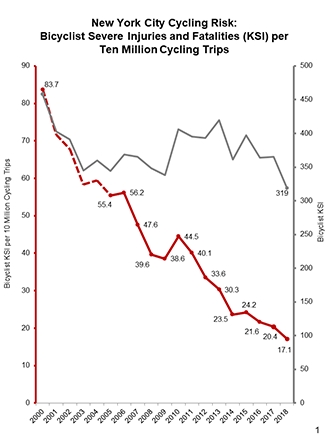
Bicyclists killed or seriously injured (KSI) is roughly flat since 2000 (around 350/yr)
The rate (per 10MM trips) dropped from ≈80 in 2000 to ≈10 in 2018
In a 2014 analysis, incidence of cycling death took place at a mean rate of 4.7 deaths per 100 million kilometers cycled in the U.S., compared to 1.3 deaths per 100 million kilometers in Germany, 1.0 in the Netherlands, and 1.1 in Denmark.[6] In the United Kingdom, cyclists have half of the rate (killed and serious injury per km) of motorcyclists but eight times the rate for motorists.[7]
Speed
Cities are often the safest places to cycle, because cars aren't going as fast:
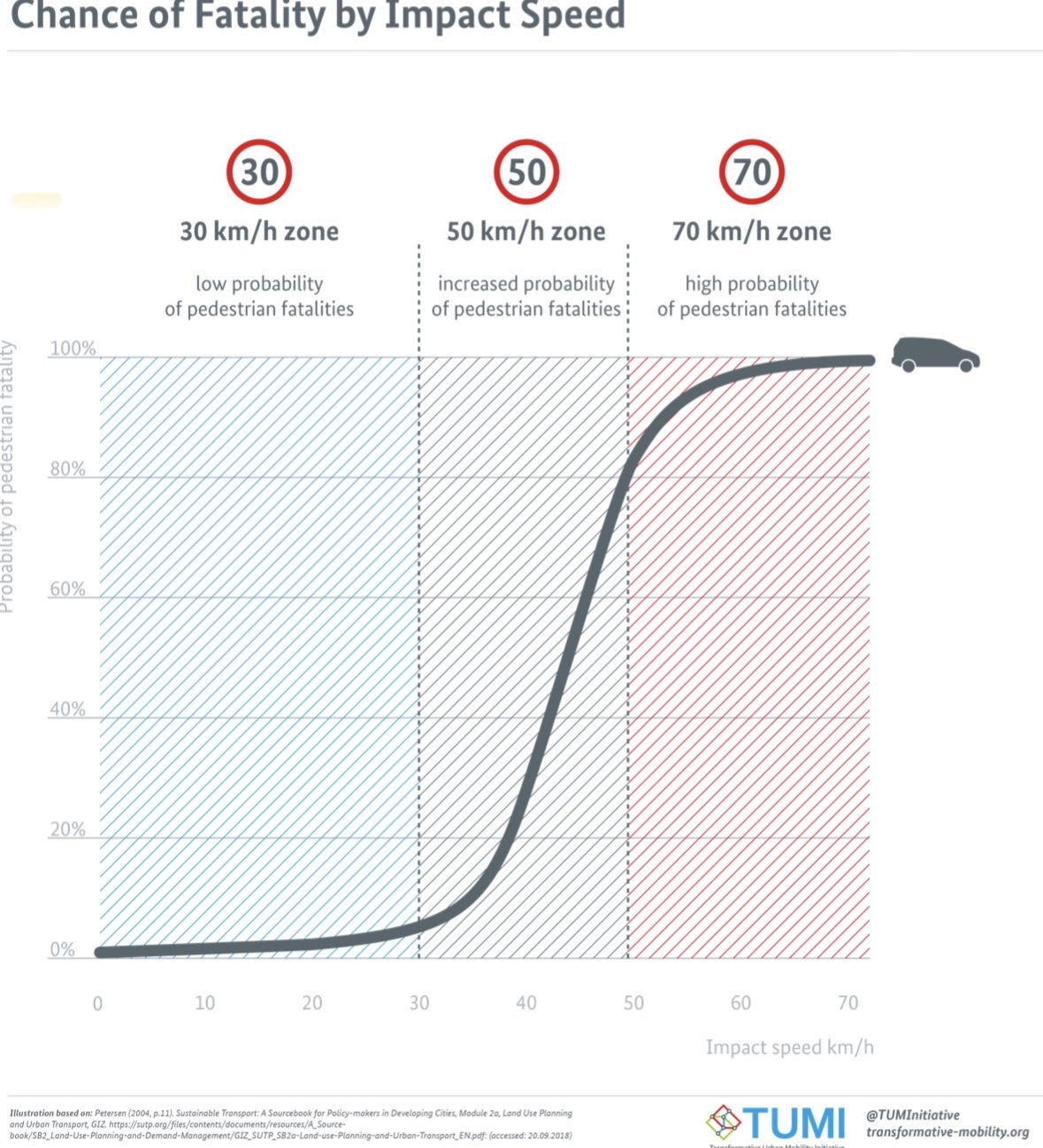
Biking is often safer if you can match the speed of traffic, which is one reason I feel much safer on ebikes.
Fear
As I've ridden longer, and as cycling infra has improved around me, I less frequently run into situations that scare me or spike my blood pressure. I've become more deferential to pedestrians and the letter of the prevailing traffic laws. The whole cycling experience has become de-adrenalized a bit.
That's allowed me to notice that fear is consistently the reason that I make mistakes, break traffic laws, etc. A driver will do something scary, or I will find myself extremely vulnerable on a road designed for cars, and my priorities shift. I generally don't fault vulnerable road users prioritizing their safety.
Riding on sidewalks
Cyclists would rather be on roads than on sidewalks, but will always use sidewalks where roads are not safe.
The solution to sidewalk-riding nuisances is to make roads safe for cycling. Pedestrian/Cyclist conflicts are a distraction from cars' being allocated most public space.
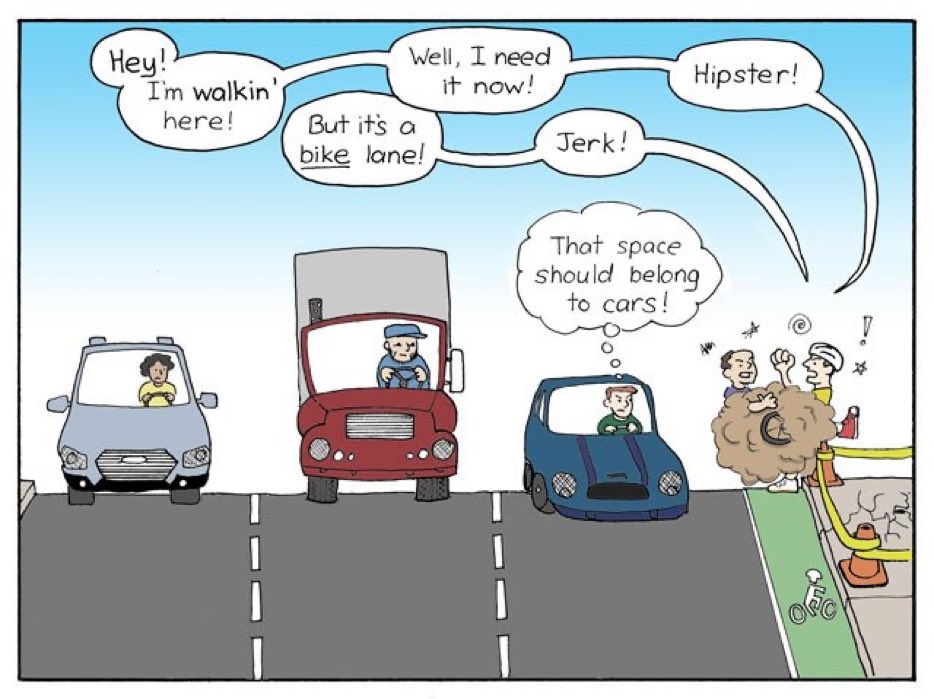

Stopping at stop signs + red lights
Cyclists should stop at stop signs and wait at red lights, but a 250lb cyclist+bike running a stop is very different than a driver doing so (in a 4000lb car with its own climate and sound system, and a 100mph top speed):
A cyclist slowing (e.g. to yield to any pedestrians present) before rolling through a stop sign at 5mph has similar kinetic energy as a car rolling through a stop at 1mph.
Cyclist also generally have better situational awareness than a driver, and more at stake (being more vulnerable in the event of a crash).
Several states have "Idaho stop" laws, which allow cyclists to treat stops as yields and lights as stops. These are great, not least of all because they emphasize yielding to pedestrians in a way that gets lost when cyclists have been overlooked (and asked to follow rules made for cars, by default).
Braking
Sheldon Brown on front brakes is a good read; beginners are taught to be careful with the front brake (left hand), to avoid potentially going over the handlebars. As you get more comfortable riding, you should reincorporate the front brake for maximum stopping power.
Helmets
I always ride with a helmet, but a lot of discourse around helmet-wearing involves blaming cyclists who are victims of bad infrastructure and negligent drivers; this distracts from discussion and action around the root issues.
Helmets are rare in the best cycling cultures; they are a symptom of dangerous roads that should be addressed directly.
50%-70% of all traumatic brain injuries occur in car crashes; arguably better policy is to require helmet for car occupants:
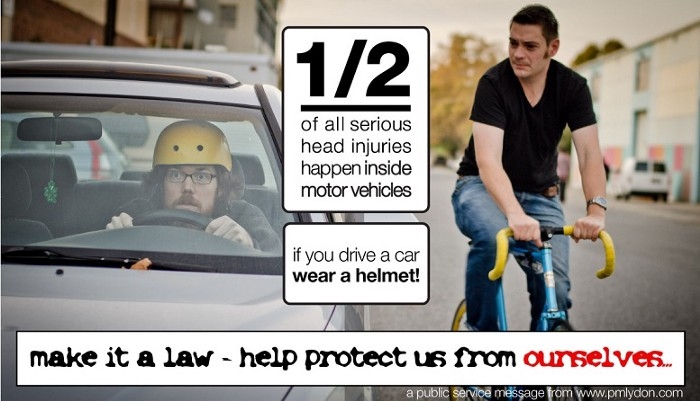
See also: discussion of specific helmets is in the "Gear" section.
Lights
Lights are definitely useful for safety; "more" is "merrier" as far as I'm concerned.
Something I like about ebikes is that most of them have integrated lights. Not having to fuss with charging separate lights makes the whole process of riding safely at night much simpler.
See also: discussion of specific lights I like.
Hi-Viz Clothing
I usually wear this $15 pink hi-viz vest while riding:
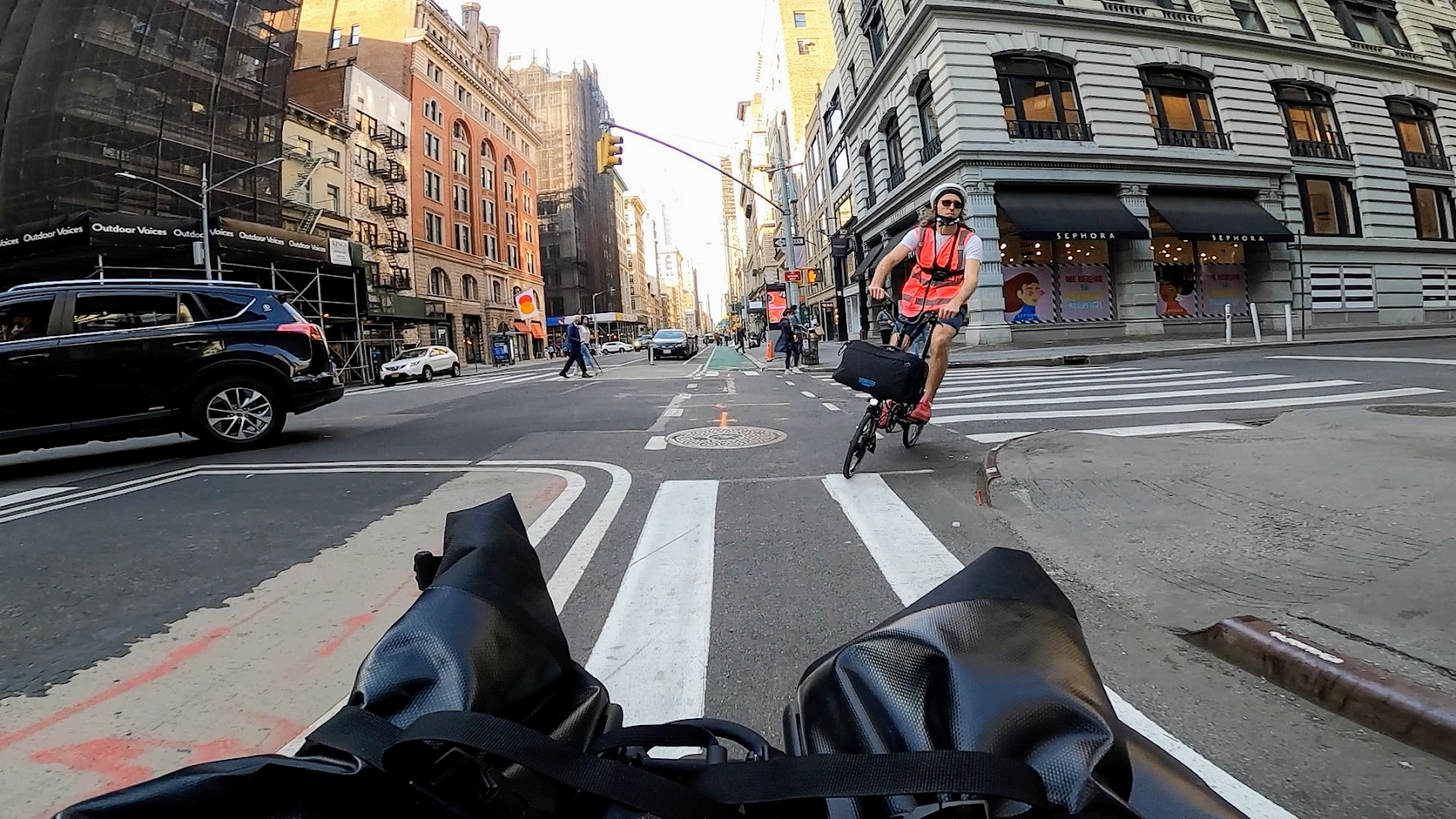
Drivers seem to mess with me less when I'm wearing hi-viz.
This Amazon vest also lets you print custom images on it:
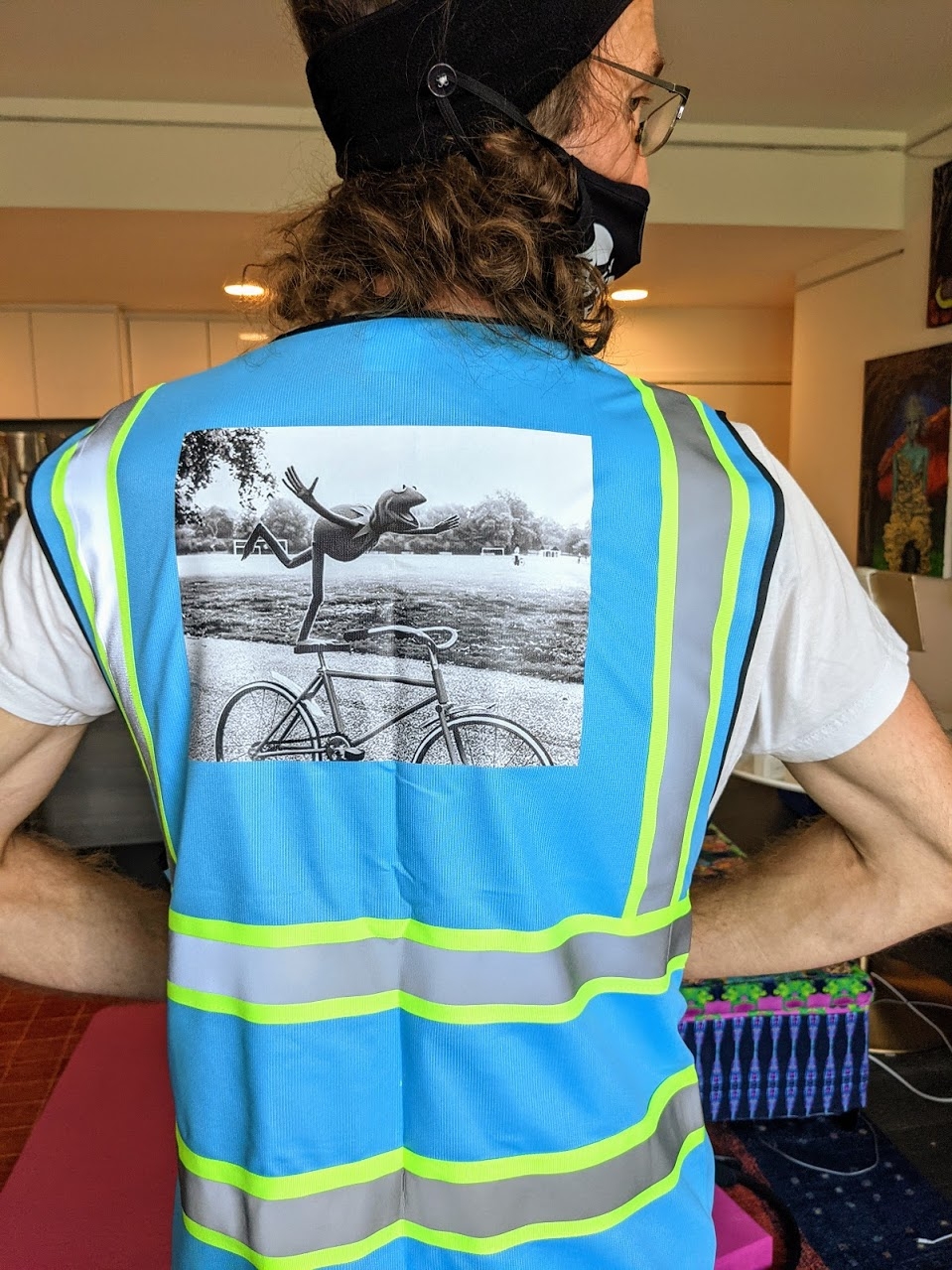
Route Planning
Street View
Google Maps Street View has been indispensable for checking out roads before riding them.
Ironically, it can even help identify when Google Maps directions are sending you somewhere unsafe, like this 4-lane, 50mph no-shoulder highway:
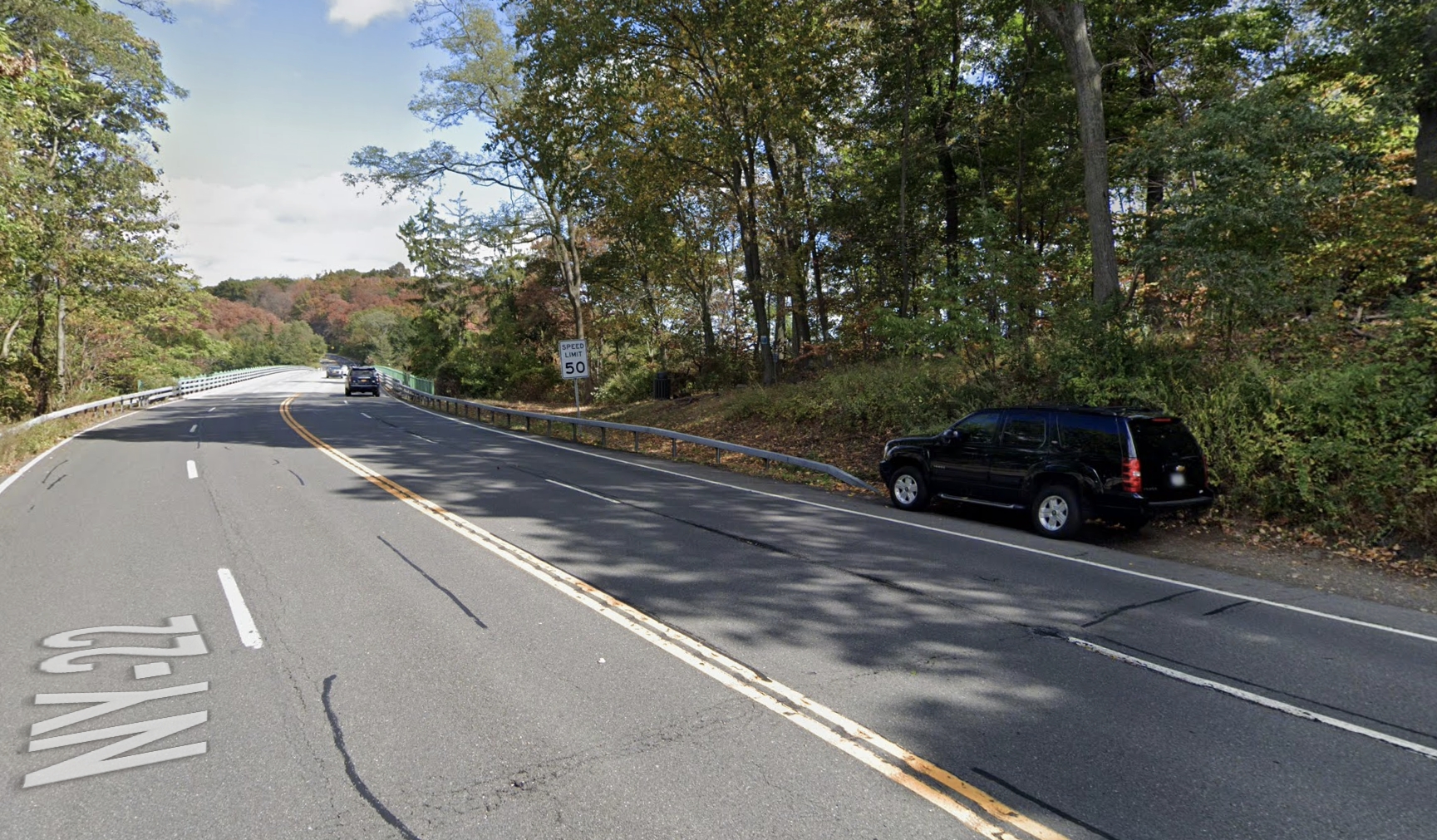
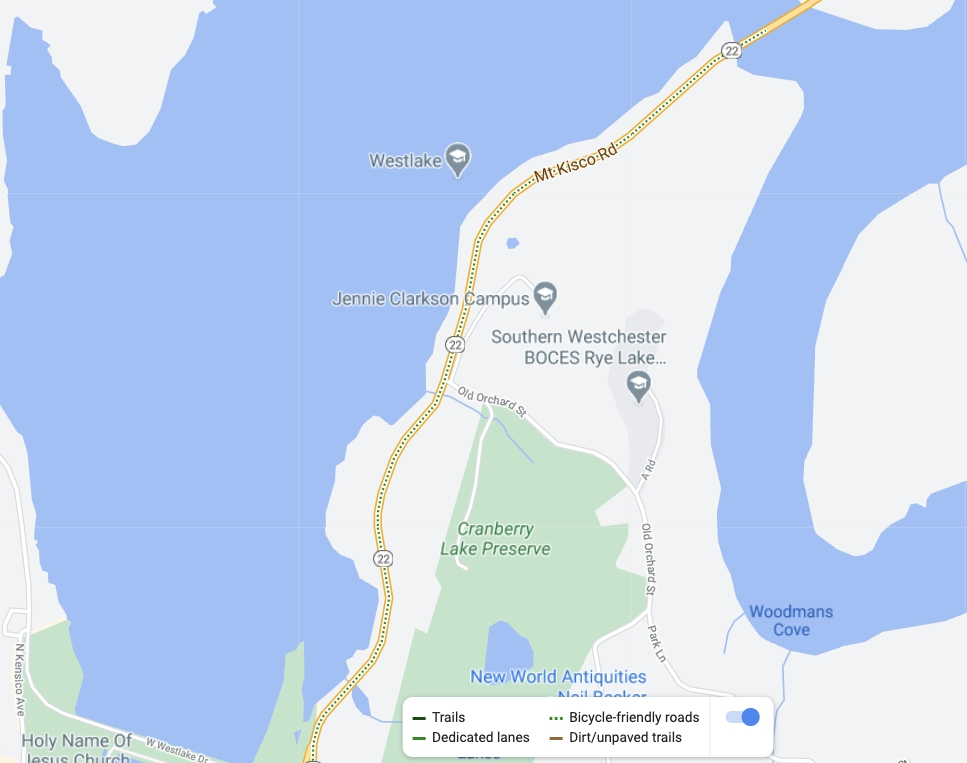
I also used Street View extensively when making bit.ly/mellowbikewestchester (discussion below); after a while you can get pretty fast at warping ahead by many increments, zooming in to scan for speed limit signs, and using the map detail in the lower-left to teleport longer distances, but it gets a bit tedious after a while. An interface better tailored to this use case would help.
I've also been surprised not to find any decent map apps that make it easy to see roads' speed-limits at a glance. I suspect the required data may exist in OSM, but haven't had a chance to explore it much yet.
Ride with GPS
ridewithgps.com is one of the best tools for planning/sharing/discovering bike routes.
For example, here's someone's route up Manhattan's West Side Highway and looping between the George Washington and Tappan Zee bridges:
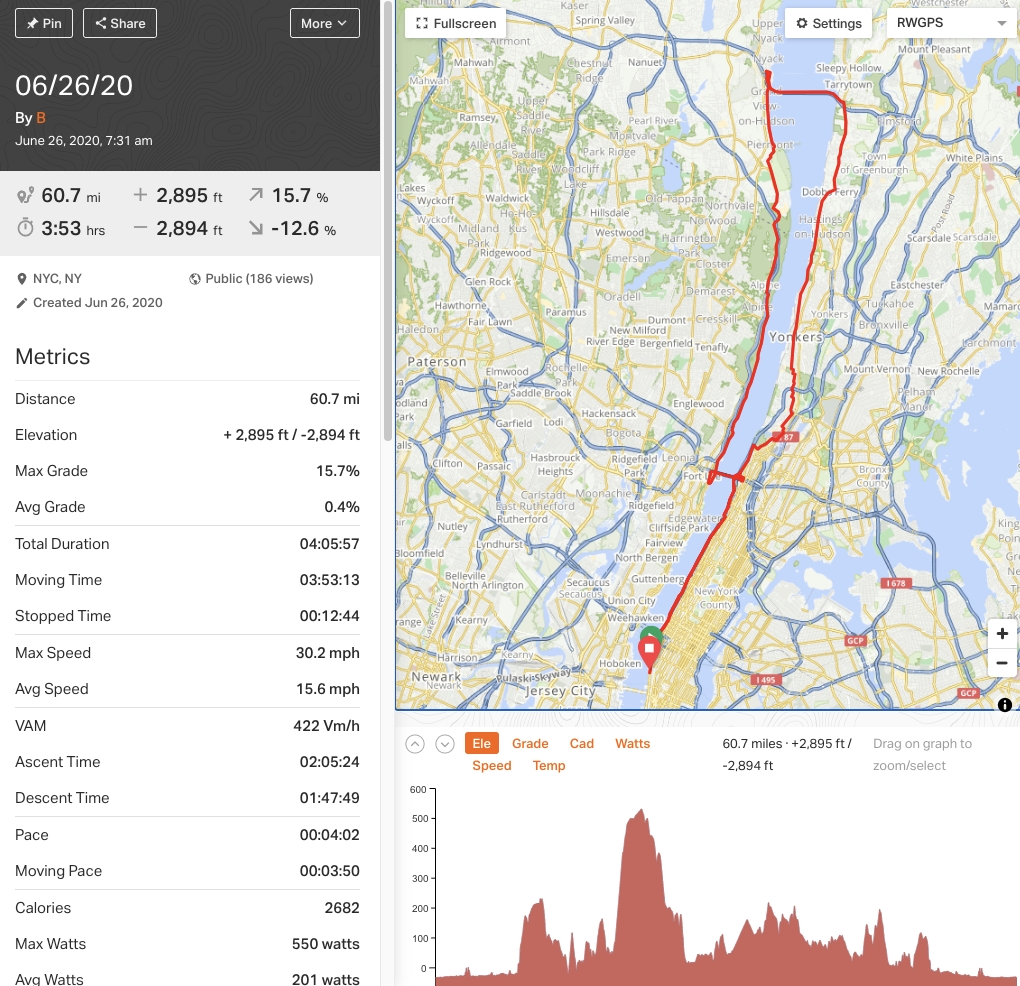
Here is a route I made (and hope to ride soon) that includes 23 NYC bridges (all Manhattan bridges and a few in Brooklyn and Roosevelt/Randall's Islands) and 1 boat:
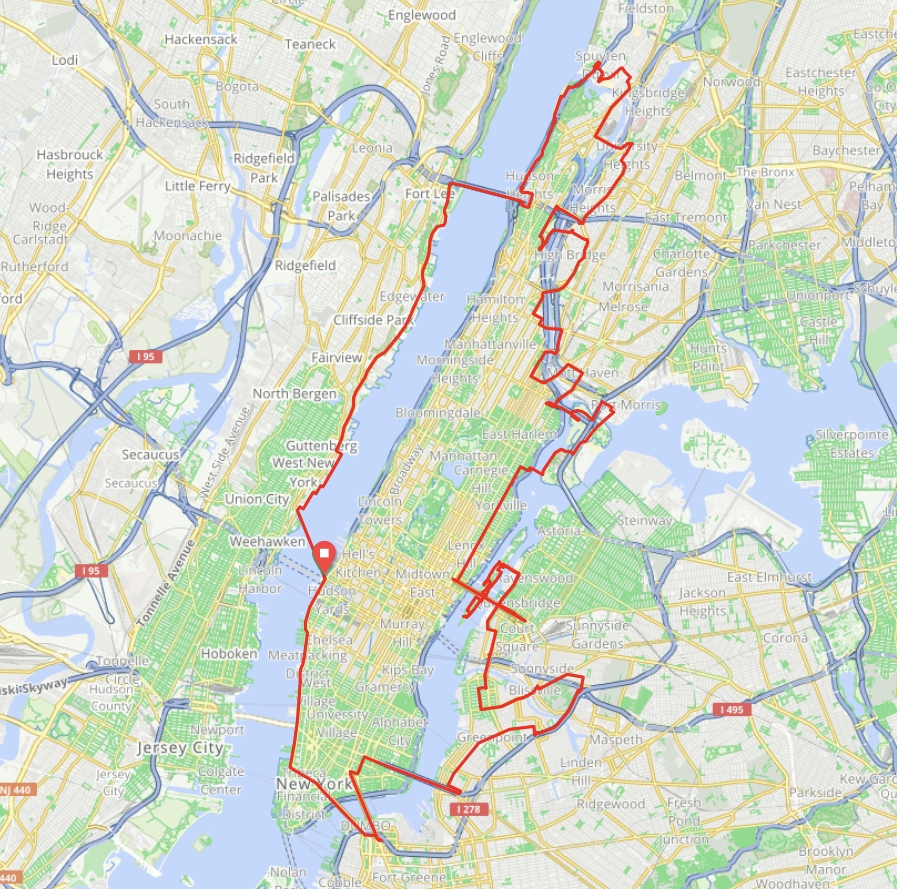
Strava
Strava also has route-planning features that seem decent; here's the same "23 Bridges 1 Boat" route on Strava.
Both Strava and RideWithGPS make it easy to export and import things in GPX or other formats, so data portability is easy, which is refreshing.
"mellow bike maps"
Inspired by the Chicago "mellow bike map", I made a "mellow bike Westchester" Google map while staying up there for a few weeks and trying to plan rides (for myself and others less experienced, where it was extra important not to accidentally end up on no-shoulder 45mph roads):

Traveling with E-bikes
Flying with Ebikes
This is mostly a non-starter as ebike batteries are generally larger than the FAA and commercial airlines' allowable limits.
Lithium batteries with more than 100 watt hours
Carry On Bags: ❗️ Yes (Special Instructions)
Checked Bags: ❌ No
Lithium batteries with more than 100 watt hours may be allowed in carry-on bags with airline approval. One spare battery, not exceeding 300 watt hours, or two spare batteries, not exceeding 160 watt hours each, are permitted in carry-on bags. For more information, see the FAA regulations on batteries.
For more prohibited items, please go to the 'What Can I Bring?' page.
❗️ The final decision rests with the TSA officer on whether an item is allowed through the checkpoint.
I think the electric Brompton is within the limit here, as its battery is 300Wh, and the bike itself folds up small enough to fit in an overhead compartment (and can also be checked).
A folded Vektron can fit into a large checked bag, in principle, but I don't know of a way to fly with the 400Wh battery.
The VanMoof and Creo don't fold, and would basically have to be taken apart to be shipped, and their 504Wh and 320Wh internal batteries are too large to fly commercially.
Trains, Boats
Other modes are generally friendly to multi-modal travel that includes e-bikes:
Amtrak's Bike FAQ says:
Electric bicycles under 50 lbs. are allowed in checked baggage and on trains with walk-on bicycle service. Gas-powered motorized bicycles are prohibited.
That means all my e-bikes should be allowed (the Vektron weighs in at 49lbs, without anything on it; with bags/etc. mine is in the mid/high 50's, but since it folds up I am optimistic it would be allowed)
I frequently bring ebikes on the NY Waterway ferry (between NYC and NJ)

I've run in to a couple of grey areas:
The Port Authority recently banned e-bikes on PATH trains at all times, though there's been a lot of pushback and some signaling that they are not planning to enforce it (at least not very strictly).
Metro North Railroad's bike policy seems to prohibit electric bikes, though we've taken the Creo and Vado on them without a problem:
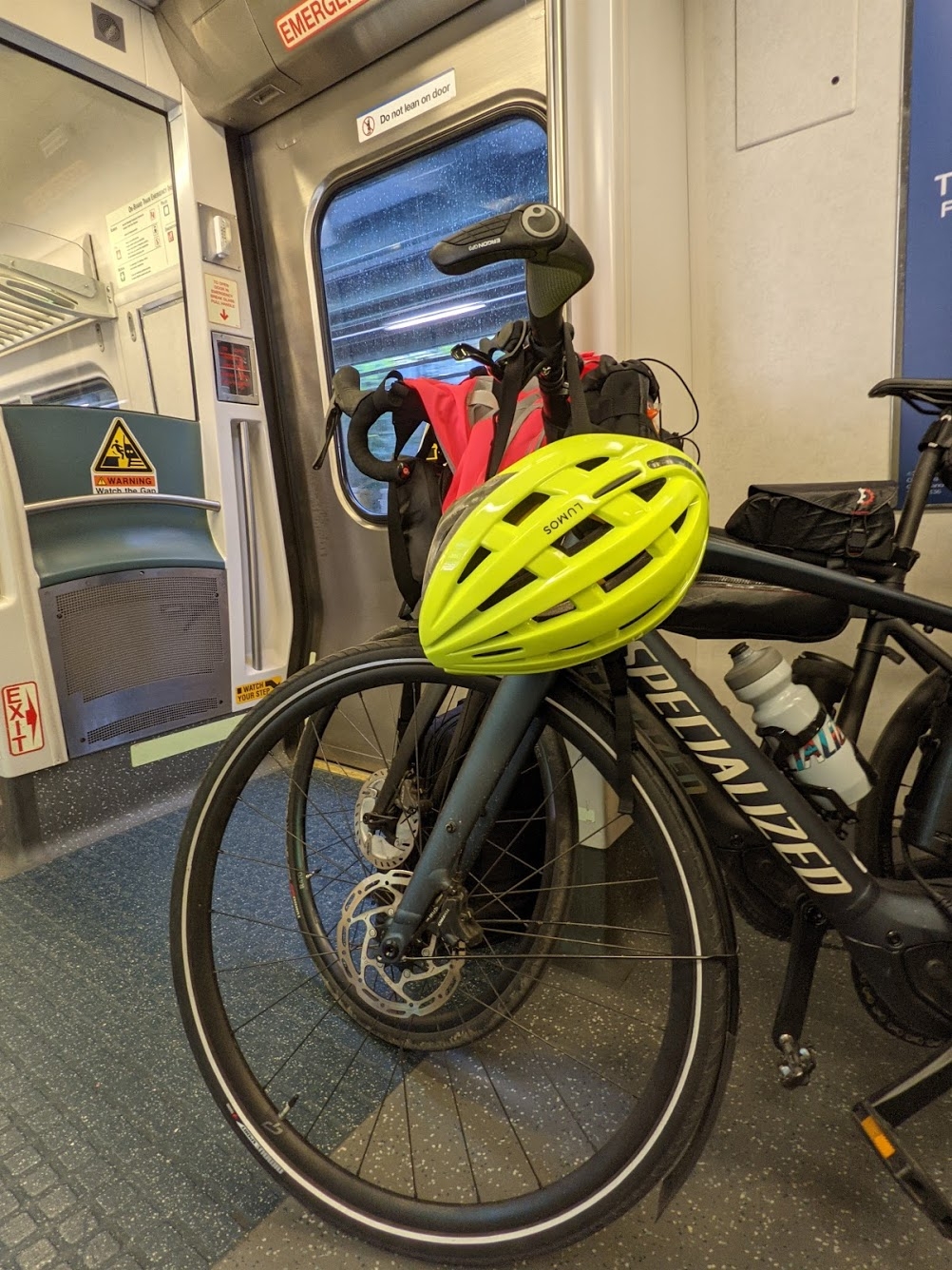
In general, some e-bike prohibitions seem aimed at heavier-duty (esp. throttle) e-bikes; my pedal-assist bikes generally look/weigh/fit similarly to regular bicycles, and get a pass.
Starter Packs
VanMoof X3 ($2300; $3k w/ "Peace of Mind" plan)
The VanMoof X3 is the cheapest of my 4 ebikes, but is the best all-around and my go-to e-bike for trips around greater NYC.
It starts at $2300, but I added:
VanMoof's 3yr theft+maintenance plan ($590);
front basket ($89), back rack ($69)
my standard mounts + bags ($250)
fleece-lined pogies ($47) for toasty hands in below-freezing temps (I've only had it during winter months, so far)
bungee cable set ($14) for securing items in the front basket
Extra battery ($350)
Still waiting on delivery, have not needed it that badly
Excited to be able to go on longer rides (it should extend my range, using liberal boost, from ≈30mi to ≈50mi)
This $3k-$4k package should let you replace/improve a wide class of trips that you'd otherwise use other modes for. See more discussion here. Also, the bike + plan can be financed for $83/mo.
RadPower: <$2k
RadPower are a popular brand that is aggressively targeting a lower-pricepoint, mainstream audience. My 5th/next e-bike will likely be a RadWagon; they seem to be easy to order online and shipping reasonably quickly.
Reading
This was consistently one of the highest-quality review sites I saw. I learned to seek them out on a Google results page, or go there directly to search for a specific bike.
They did the best job of showing critical stats about bikes in an easy-to-scan format, especially including stats that the industry is sheepish and user-hostile about (*ahem* bike weight *ahem*).
Here's are their reviews of a Creo similar to mine and my Tern Vektron Q9. Their brand pages are great too: the Specialized reviews page was very useful in sorting through a bunch of confusingly-named models.
Nice forum with encouraging/inspirational stories and examples
Vendor-specific subreddits are often, e.g. r/vanmoof or r/brompton.
Last updated
Was this helpful?